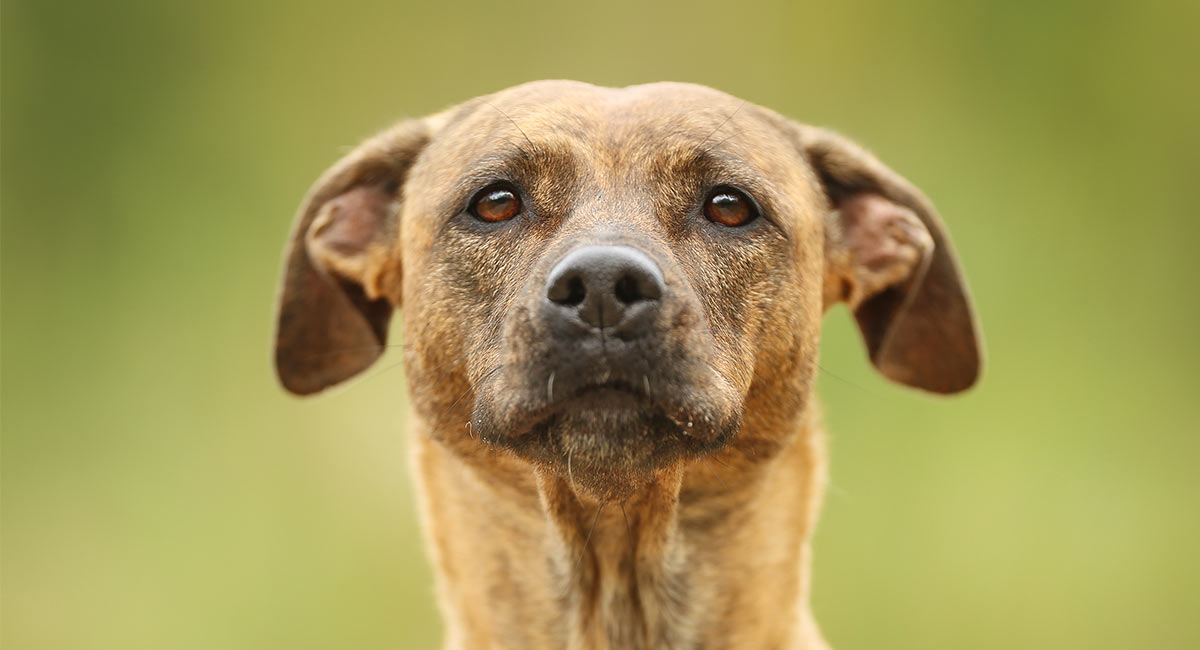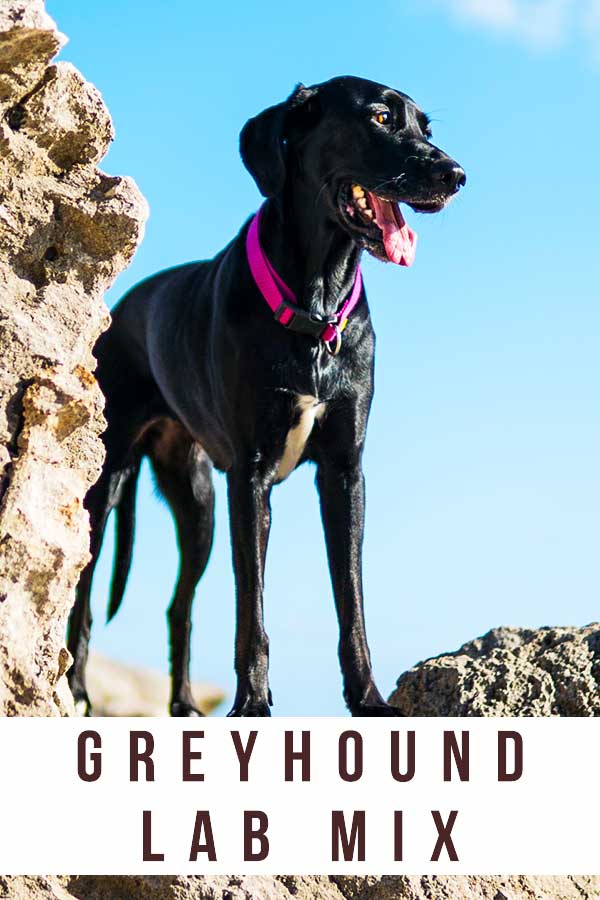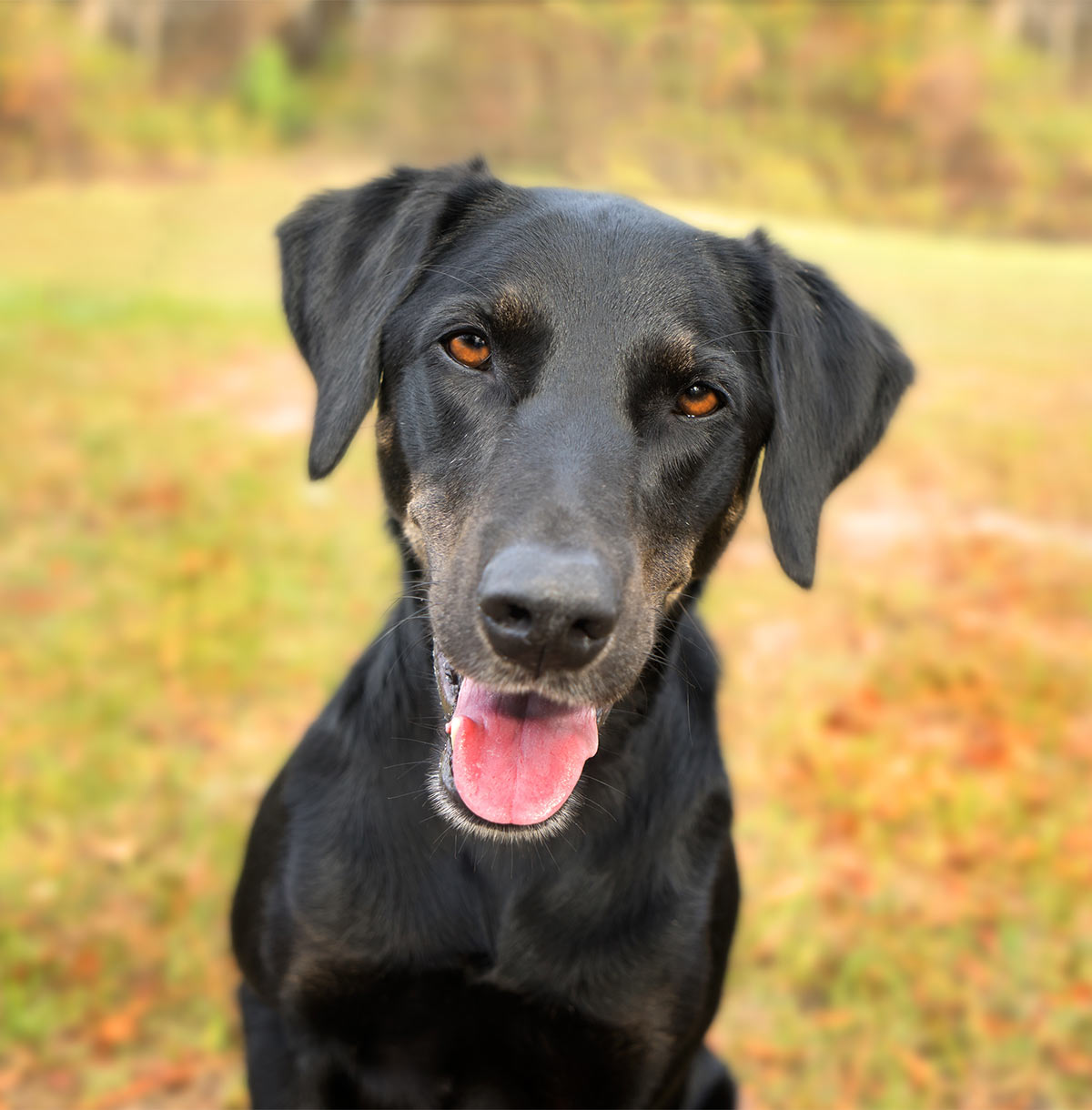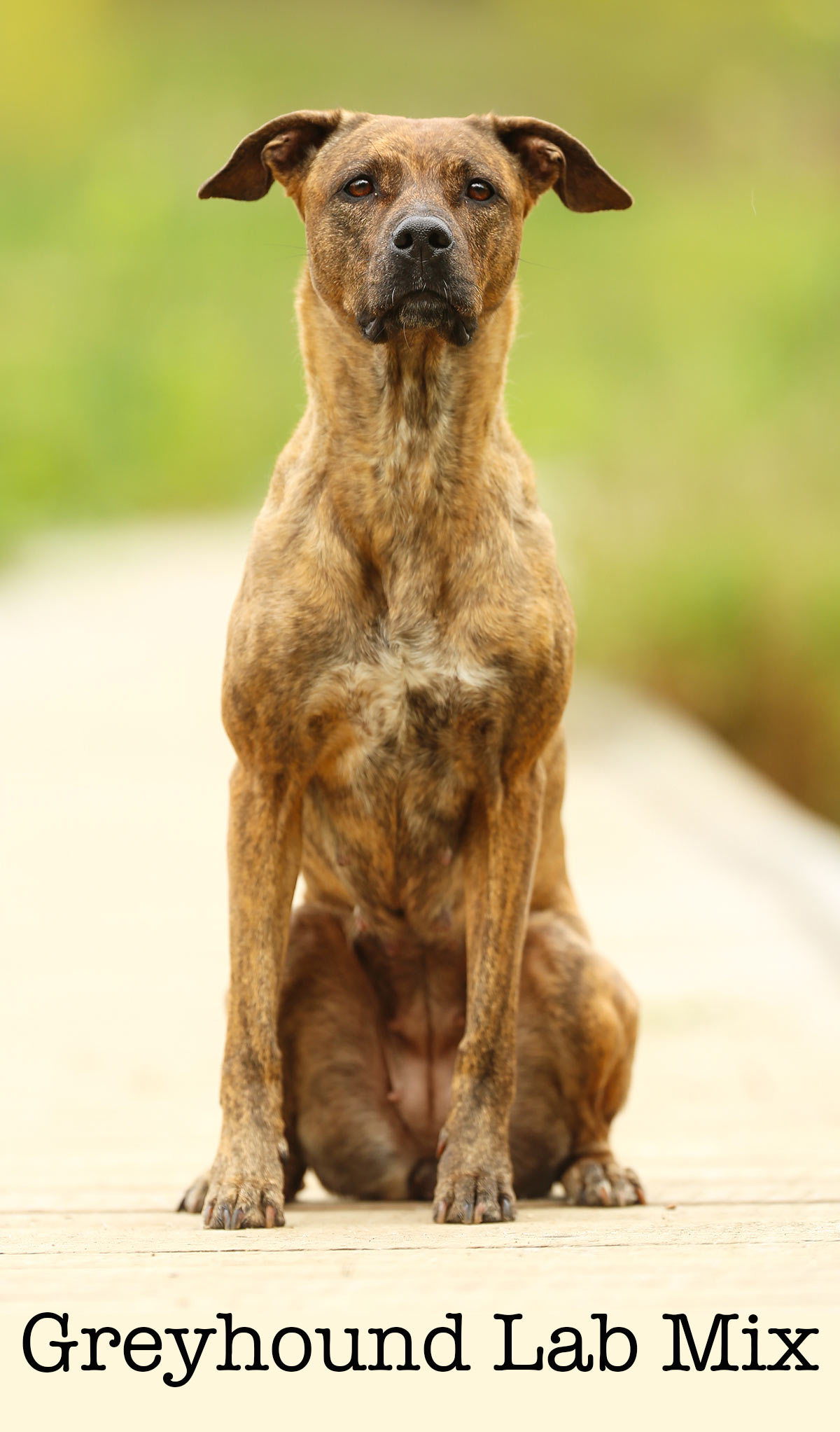Greyhound Lab Mix – Your Complete Guide To The Greyador
The Greyhound Lab mix, or Greyador, is a designer hybrid breed, perfect for admirers of the Lab’s good-natured personality and the Greyhound’s elegant looks. They are powerful speedsters, with a furious prey drive but a family focused, face licking level of love for their humans.
Lab and Greyhound traits can combine in virtually any mix in a Greyador, affecting appearance, size, temperament, and health issues. Greyhound Lab mix dogs tend to be confident but reserved, slimly built and have incredible acceleration. Provided they are well exercised during the day, your Greyhound Lab mix will happily curl up on your feet all evening. Or try their best to climb into your lap.
- History and original purpose
- Appearances and temperament traits
- Training and exercising
- Puppies and shelter dogs
Today I’ll share all you need to know about Labs, Greyhounds, and the Greyhound Lab cross, so you can decide if the Greyador is the perfect dog for you.
Origin of the Greyhound Lab Mix
The Greyhound is an ancient breed of dog that’s part of the Sighthound breed group. Breeders developed this breed centuries ago to help hunters spot small game animals (like rabbits), and chase them down at a high speed. This sport is known as coursing. After this, Greyhounds became a common sight in dog racing sports. The Greyhound is often still used in this controversial sport. Nowadays it’s trained to chase a lure on a racecourse.
The Lab is a Retriever-type dog and belongs to the Sporting group. It was first bred in Canada to be a working dog for coastal fisherman. Wildfowl hunters used the Lab as a retrieving dog. The Lab’s affinity for water and obedient temperament made it an ideal retriever of waterfowl brought down by hunters. Travelling noblemen brought Labrador ancestors across to Britain, where they continued to refine the breed.
Greyhound Lab Mix Appearance
Many fans of the Greyhound Lab mix seek a dog that combines the Lab’s sturdiness with the Greyhound’s refinement. But there is no guaranteed Greyador appearance. Mixed breed dogs can inherit the physical characteristics of either parent breed. Some Greyhound Lab mixes can look more like Labs and some more like Greyhounds. The most accurate way to predict is to look at the two parent dogs. And, make sure you’re happy with any combination of their characteristics.

Greyador Size
How big is the average Greyhound Lab cross? Greyhound males weigh between 60-75 pounds. Females are 60-65 pounds. The average male Labrador Retriever is 65-80 pounds; female Labs are 55-70 pounds. Expect your full grown Greyador to weigh between 60-80 pounds for males and 55-75 pounds for females.
While Labs weigh more than Greyhounds, the Greyhound is generally taller than the Lab. An adult male Greyhound can be 30 inches in height at the withers, while the tallest Lab tends to be under 25 inches in height. The average Greyhound Lab mix dog’s height can vary from 21-27 inches.
Size ranges for the Greyador are broad, which is typical for mixed breed dogs. Your dog can inherit features from either breed.

General Appearance
The general appearance of a Greyador will be an unpredictable mix of the two parent breeds. The Greyhound’s aerodynamic body was built for speed. From the long, slim head to the deep chest and narrow waist of a long-distance runner. But, Labs can look stockier, with a general strong and athletic appearance. Compared to the Greyhound, Labs have broad features, including their heads and tails.
Coat Type and Colors
Many potential owners of Greyhound Lab mix pups are interested in learning about the possible coat colors and textures of this mixed breed, including the amount of shedding to expect.
Labs have a double coat consisting of a short dense top coat and a soft thick undercoat. The undercoat sheds in warm weather. Greyhounds have a smooth, short coat. The Greyhound’s coat is relatively low maintenance and sheds as much as the average dog. The Lab’s double coat makes it a more profuse seasonal shedder, They generally need more frequent grooming than a Greyhound. The Greyador coat is usually dense, smooth, and short in length. It’s safe to expect a similar amount of shedding and grooming to the Lab, given that your dog can inherit the Lab double coat.
What About Coat Color?
Many potential owners are interested in specific colors like the black Lab Greyhound mix, yellow Lab Greyhound mix, or chocolate Lab Greyhound mix.
Solid black, yellow, and chocolate are the only officially recognized Lab colors. The Greyhound has a much wider range of accepted colors and markings. They can be many different colors, both solid and brindle. A lot of Greyhounds are white with colored markings (parti-colored).
Greyhound Lab mixes have more variety in color than Labs, because the Greyhound is so varied in color. Your Greyhound Lab mix can be solid or brindle, or parti-colored as well. Possible Greyador colors include silver, blue, grey, brown, black, red, and fawn. When browsing pictures of Greyhound Lab mix pups online, you will notice a lot of black or mostly black dogs. The black Lab and Greyhound mix is an especially popular cross breed, but many colors and markings are possible.
Greyhound Lab Mix Temperament
Just like their appearance, the temperament of all mixed breed dogs can be any combination of the traits of either parent breed. Every dog is an individual, and training and socialization play a larger role than breeding in giving you the kind of dog you want.
While Greyhounds tend to be somewhat quiet, sensitive, and gentle, Labs have a reputation for being active and friendly. Labs are always eager to please and ready to play. The lovable Lab personality is legendary. The Greyhound’s and Labrador’s fundamental personality differences are due in large part to what each breed was developed to do. Sighthounds like the Greyhound are generally calm and independent dogs. While some Sighthound breeds have aloof personalities to match their noble looks, Greyhounds are famously sweet-tempered and affectionate.

Natural Instincts
One important personality trait to be aware of in Greyhounds and Greyhound mixes is their strong prey drive. They were bred to hunt small game using sight and speed. So all Greyhounds should be tested for prey drive before being introduced into homes with small animals like cats. Retriever breeds like Labs are part of the Sporting dog breed group, along with other active and amicable breeds like Spaniels, Setters, and Pointers.
The Greyhound Lab mix could have an appealing combination of the Lab’s enthusiasm tempered by the Greyhound’s calm. Although it could equally have one or the other extreme. You can generally expect a friendly and non-aggressive dog, especially with proper training from an early age. Make sure you take the prey drive of your dog’s Greyhound ancestors into account when introducing one into a household with other pets.
Your dog’s Greyhound blood may also make it a bit more sensitive around boisterous young children than its easy going, rough and tumble Lab ancestors. Be sure to supervise your dog around children.
Greyhound Lab Mix Socialization
Because of these natural instincts, it’s important to socialize a Greyador puppy well. From the time you bring your puppy home until the age of 16 weeks, you should introduce them to as many new things as possible. This includes people, places, animals, vehicles, and more. Anything that your dog may interact with as an adult.
For Greyador puppies, there should be a particular emphasis on small animals and very young children. Socializing puppies can reduce aggression and fearfulness in adult dogs of any breed.
Training and Exercising your Greyador
Both Labrador parents and Greyhound parent breeds are intelligent and athletic dogs. So, they will benefit from regular exercise and training. Labs and Greyhounds have histories as sporting and working dogs. Their mixed puppies will need plenty of exercise each day, including time to run off leash. Because of the risk of a strong prey instinct, you will need to find a safe, enclosed area to allow this or have a rock solid recall.
Training can offer a small amount of exercise, as well as some much needed mental stimulation. But, be sure you don’t over-exercise your dog when they are a puppy to protect their joints.

Greyhound Lab Mix Health and Care
Potential Greyhound Lab mix owners should educate themselves about the health problems of both Labs and Greyhounds. The Lab parent must have good hip and elbow scores, be PRA clear and have an up to date eye test. As a minimum the Greyhound parent should be PRA clear and have no family history of polyneuropathy.
Your mixed breed dog is not necessarily healthier than purebred dogs if the dog is bred from two purebred lines with known health problems. Knowledge of the health history of your dog’s parents, including written certifications and genetic test results, is key to making sure your Greyador is healthy. There are tests available for many common genetic conditions. Reputable breeders will share this important health information with clients.
Greyador Life Expectancy
Life expectancy for Greyhound Lab mix puppies will vary depending on their lifestyle, general care, and inherited health issues. To get a general idea, you can look at the average life expectancy of the two parent breeds. According to a 2013 study by O’Neill (et al), the average lifespan of Labrador Retrievers is 12.5 years, but the average lifespan of the Greyhound is only 10.8 years.
These are only averages. So, the parent breeds can live much longer than this. But, it’s a good general idea of how long a Labrador Greyhound mix will be in your family.
Do Greyadors Make Good Family Pets?
The Lab Greyhound mix can be a great pet for anyone interested in a loyal and affectionate canine companion. Both parent breeds of the Greyador have appealing personality traits. But it’s important to remember that your dog can inherit any combination of the Lab and Greyhound temperaments. The best way to ensure that your dog is well socialized and well behaved is to start the training process as soon as you get your new Greyhound Lab mix puppy.
Before you fall in love with an individual puppy, make sure you understand all the possible health conditions associated with both the Labrador Retriever and Greyhound breeds. A chase instinct is highly possible in this mixed breed. So, it may not be the best option for homes with other small pets. Owners must have the time to socialize and train them well from a young age.
Shelter Dogs
Is it possible to adopt a Greyador from an animal shelter or rescue organization? Most Greyhound rescue organizations work with purebred retired racing Greyhounds. There are many Lab rescue groups around the country, and it’s a good idea to talk to local Lab rescue groups and let them know you are interested in a Lab Greyhound mix.
You also may be able to find a Greyhound Lab mix that has been surrendered to an animal shelter. Most shelter pet search websites allow you to search available dogs by breed. Shelters do their best to identify the mixed breed dogs in their care, but you can also confirm a dog’s ancestry through genetic testing.
Your Greyhound Lab Puppy
Greyhound Lab Mix puppies are not as common as some other Lab mixes like the Labradoodle, so be patient and take your time researching reputable breeders. Reputable breeders are concerned about the overall health of the breeds of dog they work with and would not knowingly sell puppies afflicted with a serious medical condition.
Getting a dog is a lifetime commitment, so be sure your new Greyhound Lab mix is as healthy as possible. The result of any cross breeding is never 100% guaranteed, something new owners need to remember. The sturdy Lab and elegant Greyhound can combine into a beautiful medium sized dog with a short coat that can come in a variety of colors and patterns.
Less experienced dog owners can benefit from formal training classes like puppy kindergarten so that their dogs get a good foundation from an early age. Labs are highly trainable, and Greyhounds are generally calm, all of which can be very helpful for new Lab Greyhound mix owners.
Greyador Breeders
Interested in acquiring your Greyhound Labrador mix puppy from a breeder? Here are a few common-sense tips to keep in mind as you begin your search. Be cautious of online ads for Greyadors or any designer mixed breed dog. Large scale, for profit breeding operations (often referred to as puppy mills) should be avoided. Since both Greyhounds and Labs are known to have some significant genetic health conditions, the best way to ensure that your puppy will be healthy is to work with a reputable breeder who will share health information with you.
Remember that an unusually inexpensive puppy bought sight unseen may cost you much more in long term veterinary expenses than a pricier dog from a known breeder. It’s a good idea to choose a local breeder who welcomes potential buyers to their home, so you can see the environment where your puppy is raised. Be sure to meet your puppy’s parents and observe all your puppy’s littermates.
Health Testing
Labradors can be screened by x-ray for hip and elbow dysplasia. There are genetic tests available for certain heart and eye conditions, as well as centronuclear myopathy and exercise induced collapse. Greyhounds can also be tested for some of the serious genetic health conditions that are common in the breed. Experts recommend that, at a minimum, your dog’s Greyhound lines should be tested for polyneuropathy and thyroid, heart, and eye diseases.
Genetic tests can tell breeders which of their dogs are unaffected, which are carriers of a disease, and which are affected by the disease.

Free Labrador Updates!
Get my training tips, news, reviews, and the latest from The Labrador Site delivered to your inbox



We’ve just discovered our almost 4 year old rescue dog is a mix of labrador and 3 types of sighthound. We adopted him in March 2020 and recently got a DNA test done with Embark. Thank you for the information above. It will help us with his training schedule and the best way to care for his health. I was surprised that he had any labrador in him but on further reading about the breed there are definitely similarities.
Thank you so much for sharing your article! I just adopted a beautiful black Greyhound Lab. She has a wonderful, sweet temperament and gets along amazingly well with my Bully. To make a long story short, I went to the shelter looking for another Bully for Titan, but instead stumbled upon Gypsy the Greyhound lab, a very rare treasure.
Hi, My greyador, Cal, died from osteosarcoma a few months ago, at the age of 9. I am beyond heartbroken, but am starting to think about taking in a new pup, ideally a greyador. Does anyone know of breeders or adoption programs that focus on this mixed breed? Thank you for any intel. Peace.
Just adopted one and he is so sweet and just so friendly towards everyone. Got to break him from jumping up on people.would love to hear some good ways to do that. So far I just grab him by collar and put him back down and say no…bad.but most people say he’s fine and like it. But most people I know are dog lovers so I prob would say same thing. But wow grayadors are really fun to own. I had to train this dog on everything. He’s 11 months and doesn’t know…make that didn’t know anything. He can now sit, shake and lie down. And it’s only been a week and a lot of treats to do it.Makes me wonder where he has been for 11 months.i know greyhounds are skinny but this one was underfed. Way to boney. He looks great now in just a week.coat is very shiney and black. Had runs at first but is back to normal stool.couldnt be happier. Enjoyed your article.
I have a male greyador and he is the most lovable and funny dog you could ever meet. He’s often up to mischief but I love that about him. Having said the above, one of the problems is that he loves meeting people who come to my home and wants to bounce around them. I find that for myself, I gently as possible push him down from jumping at me and calmly carry on, saying ‘Tim, not now’. He is now a lot calmer when I come in. My friend, who Timmy loves, starts raising his voice and engaging with him, which makes him wilder still (despite advising my friend not to do that) So in short I advise to keep calm and ignore the excitement as much as is possible and try to get that control whilst anyone comes to your home or around him.
We rescued a greyador last October, and she’s high energy, playful, super athletic, and just the sweetest dog. The shelter thought she was an underweight labrador, but her physique is unmistakably greyhound.
Rescued one last week. They are amazing aren’t they. Couldn’t be happier. Good luck with yours.
I have just adopted 2 greyadors from Romania. 5 weeks in and think their personalities are started to come out. Both very loving and loyal. Love there walks although not been off long leads as I’m not sure they will come back.
But loving every day with them.
My experience as a dog-owner is limited to Labs, GSDs, & Aussies. I have tried to educate myself about breeds, but now I feel like an idiot.
The young 75# “lab” dog I just got from a shelter is, I now realize, a Lab/Greyhound cross. His head is so much narrower than his 18″ neck that a collar is useless to connect to a leash. I just hope it’s secure enough to hold his tags. The foster used a slip leash.
Had we been able to visit fosters, I would have not have taken him, but between the fact that we are disabled and unable to drive, and Metro Mobility won’t go to the exurbs and small towns where most rescues are located. And, of course, NCoVD19 makes taking Metro Mobility problematic.
This foster was willing to drive over 100 miles. My husband, of course, fell immediately in love. I have seen only a couple TEENY greyhounds in my life, so it never occurred to me that a 75# dog would be a Greyador.
Now here’s my problem. I needed to train him to help me keep my footing when I walk. With a harness, he can learn to counterbalance me as needed; he’s heavy enough, but I worry because we have continuous snow cover Nov. – March/April.
Can those TINY FEET keep their footing on ice? Can I buy high traction booties for him? How would those be measured?
We are both over 70, and I’m rarely outdoors more than 30 minutes at a time. I guess I can attach a warm coat to his mobility harness. Will he need “leggings” for walks in winter, too?
Please advise.